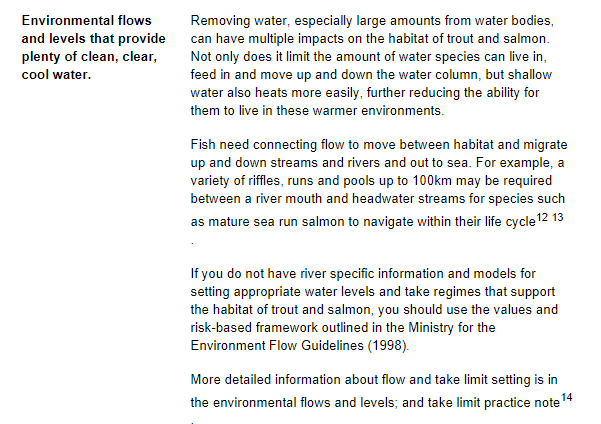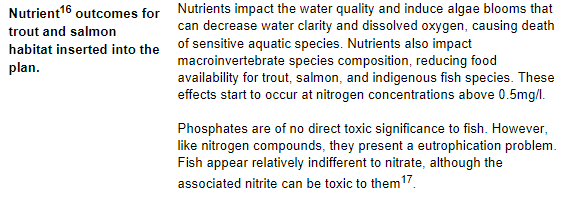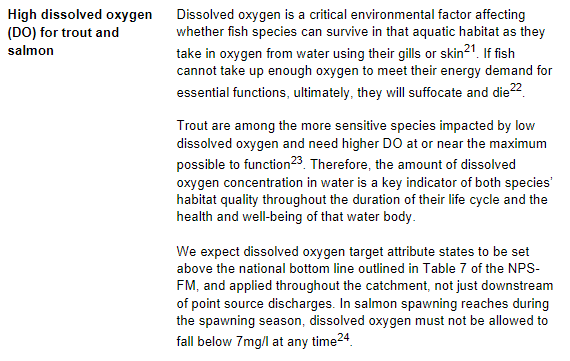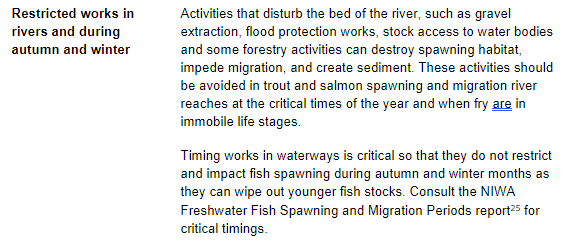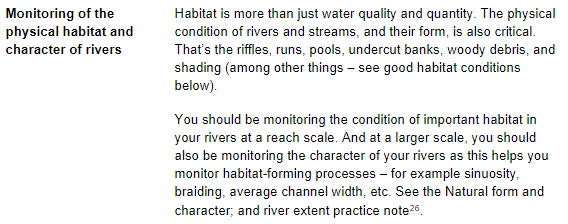Protecting the habitat of trout and salmon
Trout and salmon habitat contributes to a healthy freshwater ecosystem!
Our NPS-FM position in a nutshell
Trout and salmon habitat values need to be identified in your regional plans. The NPS-FM directs you to protect the habitat of trout and salmon insofar as it is consistent with protecting the habitat of indigenous freshwater species (Policy 10 NPS-FM). You need to know where these habitats are, and they need to be mapped in your regional plans. Fish & Game have a wealth of information to assist your mapping effort.
Trout and salmon have been in Aotearoa New Zealand waters for over 100 years and in many places can live alongside indigenous freshwater species as part of a healthy freshwater ecosystem. They have more stringent habitat requirements than indigenous species, needing very high water quality and fast water flows to live and breed in. Their presence is a great sign of fresh and healthy water bodies.
Where specific cases of species interaction between indigenous fish and trout are identified as detrimental, measures will need to be taken to protect the more vulnerable species (Coughlan 2023). This should be a decision made with the best information available (Best Information Practice Note) to inform what action is needed. It should be in consultation with Fish & Game and the Department of Conservation.
The NPS-FM directive
You must protect the habitat of trout and salmon (Policy 10 NPS-FM), while ensuring that indigenous freshwater species habitat is protected too (Policy 9 NPS-FM). This means that you must know where trout and salmon live and where they spawn, understand their life cycle, and understand how they interact with other indigenous freshwater species so that you can adequately protect them and wider ecosystem health.
Your regional plans should identify trout and salmon fishing and spawning values and protect that habitat. Fishing is a value that you must consider in your regional plan (Appendix 1B NPS-FM). Where areas that are valued for their fishing are identified, provisions of the plan should protect both the habitat that supports that fishery, and ensure conditions are safe for people to catch and consume them in a safe (Link to Improving Water Quality and Access for Swimming and Recreation Practice Note when available) and sustainable way.
Fish & Game hold a statutory role under the Conservation Act 1987 to manage introduced sport fish in Aotearoa New Zealand and their habitat. They can provide detailed information on habitat locations and advice on the attributes required specifically for trout and salmon. You should engage with Fish & Game as you develop your regional plan.
The NPS-FM directs you to include a specific fish passage objective and policies in your regional plan (Clause 3.26 NPS-FM) that identify which species are desirable (or undesirable) within a particular freshwater environment. In making those decisions, you must take into account any Freshwater Fisheries Management Plan or Sports Fish and Game Management Plan. You should engage with Fish & Game to develop policy about any population management needed in that specific area.
What do we want to see?
We want to see trout and salmon fishing and spawning identified as values in your regional plans. Fishing activities often rely on species that are widespread, so you should consider fishing and spawning values at a catchment, rather than river reach scale.
Trout and salmon presence can also be a sign of a healthy ecosystem. The fish will more likely live, spawn and be caught where the conditions support a healthy catchment. In special circumstances, it will be necessary to consider fishing and spawning at the river reach scale (rather than the catchment), for example where there is a need to identify extremely popular angling spots or to plan interventions due to detrimental species interaction. See the Species interaction resource (Link to species interaction resource when available).
The locations of fishing and spawning areas should be mapped and included in your regional plan. Fish & Game have detailed information to support this mapping exercise.
In some areas other species will also be valued for their sports fishery, for example, perch. You should engage with your local Fish & Game office to understand if and where these other fisheries are valued, and the specific habitat requirement for those fisheries.
Environmental flows, take limits, nutrient outcomes and target attribute states must be set to provide for values identified in those locations. General guidance on flows, attributes, and limits (link to Ecological flow and levels and take limits practice note when available) is provided in the practice notes on those topics. For more regional-specific information, engage with your regional Fish & Game Council (Fish and Game Structure) to determine the right type of habitat for trout and salmon, throughout their lifecycle, in your area. This can have wider benefits for the health and well-being of water bodies and freshwater ecosystems.
In particular we want to see:
12 Thompson, KE 1972 Determining streamflows for fish life, In proceedings of the Instream Flow Requirement Workshop, Pacific North West River Basin Comission, Portland, Oregon.
13 Raleigh, RF, Miller WJ and Nelson PC (1986) Habitat Suitability index models and instream flow suitability curves: chinook salmon. UK Fish and Wildlife Service Biological Report. 82 (10.122) page 64.
14 Link to Environmental flows and levels; and take limits practice note when this becomes available.
15 Hicks, M. (2000) Evaluating standards for protection aquatic life in Washington’s surface water quality standards. Draft discussion paper and literature summary. Revised 2002. Washington State Department of Ecology, Olympia, WA Pg. 197.
16 Link to Setting in stream nutrient outcomes practice note
17 Bell, M. C. (1973) Fisheries handbook of engineering requirements and biological criteria. Fisheries-Engineering Research Program. Corps of Engineers, North Pacific Division Portland, Oregon.
18 Cawthron Report No 1205 September 2006. Water Quality Guidelines: To Protect Trout Fishery Values.
19 Link to Setting sediment target attribute states practice note
20 Bell, M. C. (1973) Fisheries handbook of engineering requirements and biological criteria. Fisheries-Engineering Research Program. Corps of Engineers, North Pacific Division Portland, Oregon.
21 Franklin, P.A (2014) Dissolved oxygen criteria for freshwater fish in New Zealand: a revised approach, New Zealand Journal of Marine and Freshwater Research, 48:1, 112-126 DOI: 10.1080/00288330.2013.827123.
22 Dean TL, Richardson J 1999. Responses of seven species of native freshwater fish and a shrimp to low levels of dissolved oxygen. New Zealand Journal of Marine and Freshwater Research 33:99 106.
23 Dean TL, Richardson J 1999 Responses of seven species of native freshwater fish and a shrimp to low levels of dissolved oxygen. New Zealand Journal of Marine and Freshwater Research 33:99 106.
24 Bell, M. C. (1973) Fisheries handbook of engineering requirements and biological criteria. Fisheries-Engineering Research Program. Corps of Engineers, North Pacific Division Portland, Oregon.
25 NIWA (2014) Freshwater Fish Spawning and Migration Periods.
26 Link to Natural Form and Character, and river extent practice note when available.
How should the NPS-FM be implemented?
Habitat conditions for trout and salmon are recognised and provided for
Good habitat conditions are an important factor affecting wild sports fish distribution and abundance and fisheries. Providing good habitat for trout and salmon provides good conditions that support other values, including ecosystems health, and ensures clear, clean water for communities to swim in (Link to improving water quality and access for swimming and recreation practice note when this becomes available) and gather food from. Environmental conditions that affect salmon and trout catchability include the availability of good fishing habitat, water clarity, flow, water temperature, weather conditions, and at the river mouth – tides.
Although it is understood many indigenous freshwater species can tolerate lower water quality conditions than trout and salmon, there is limited data on their habitat requirements (The Department of Conservation is currently publishing a report to be released on their physical habitat requirements). Because trout and salmon have more stringent habitat requirements and become stressed more quickly in poor habitat, by providing good habitat conditions for trout and salmon you are also providing good habitat for indigenous freshwater species.
Good habitat conditions include (adapted from Vermont Fish and Wildlife):
29 Link to Riparian margins and stock exclusion practice note when available.
30 Protect habitat of indigenous freshwater species practice note
31 Link to natural form and character practice note when available
32 Link to Managing riparian margins and stock exclusion practice note when available
33 Link to Natural form and character; and river extent practice note when available.
Trout spawning and salmon population locations are mapped and identified as values
Fish & Game have detailed information on locations of trout and salmon populations in Aotearoa New Zealand. These should be identified as values and mapped in your regional plans. The New Zealand Freshwater Fish Database (NZFFD) also contains over 50,000 freshwater fish sampling records, including the location and fish species present (NIWA). Many records include information on fish abundance and size as well as physical description of the site. In addition, the Fish Spawning Indicator Tool (MPI) shows where and when fish that are sensitive to disturbance are spawning and the Fish Spawning Indicator Database (MPI) provides information for North and South Islands (not offshore islands).
Trout locations
Trout were introduced from the 1860s onwards to establish recreational fisheries in Aotearoa New Zealand (Jones and Closs 2017) and most are now naturally sustaining populations. Brown trout are among the most widespread and abundant fish species and trout are now located throughout Aotearoa New Zealand rivers (Jones and Closs 2017). Some trout are still bred and released into some rivers because populations do not sustain themselves to a level that supports the fishing effort, such as in Marlborough.
Salmon locations
Salmon populations are confined to the South Island. Salmon are particularly difficult to catch and one species, the sockeye salmon, are the only population found in the Southern Hemisphere (in the Mackenzie country), making them a prized catch (Fish and Game). Some species are confined to lakes, while others are known as sea run salmon.
Chinook salmon (also known as quinnat or king salmon) are one of the three Pacific Salmonidae that have been established in Aotearoa New Zealand (NIWA) and are highly prized sports fish here. Chinook salmon are the largest Salmonidae in Aotearoa New Zealand and are mainly located on the east coast of the South Island, including from the Waiau River to the Clutha River. The main runs occur in large, braided rivers such as the Waimakariri, Rakaia, Rangitata and Waitaki (NIWA). However, they are also located in the Paringa, Taramakau, and Hokitika Rivers on the west coast (but records on the west coast may be stray fish). Several juvenile Chinook salmon have been caught in North Island rivers; however, no consistent runs have been identified (NIWA).
Fish passage will be maintained and improved
Your regional plans must provide for fish passage (Clause 3.26 NPS-FM) for desirable species and prohibit passage for undesirable species. The same species could be in either category, depending on the local situation and sensitivity of that place, so a blanket rule will not necessarily meet the needs for your entire region. In locations where protecting the habitat of trout and salmon is identified, fish passage should be part of that protection to manage species interaction.
Fish passage is included as a minimum requirement of the Resource Management (National Environmental Standards for Freshwater) Regulations 2020 (Link to NES-F). The Department of Conservation are also responsible for managing fish passage in Aotearoa New Zealand’s waterways under the Freshwater Fisheries Regulation 1983 (Link to regulations).
The New Zealand Fish Passage Guidelines46 have been developed to establish the principles for good fish passage design. This should be a base reference for decision making relating to fish passage. The Fish Passage Assessment (Tool) has also been developed to provide an easy to use, practical tool for recording instream structures and assessing their likely impact on fish movements and river connectivity.
The Fish Passage Factsheet provides additional information for you to consider.
Trout and salmon life cycles and migration periods are provided for
Habitat for trout and salmon needs to be protected for all stages of their life cycles including during their critical migration times and locations. For example, Chinook salmon grow as adults to maturity in the sea before migrating upstream to spawn, at around three years old (NIWA). When juveniles hatch in spring, they will spend around three months in freshwater before migrating to the sea in summer.
As noted above, you must provide for fish passage (Clause 3.26 NPS-FM) in waterways to allow migration and spawning to occur for salmon and to provide habitat conditions (Clause 3.26 NPS-FM) that allow trout and salmon to thrive (NIWA). The spawning run for salmon is a notable event that also draws interest from anglers around Aotearoa New Zealand and internationally (Fish and Game). Engage your local Fish & Game to determine life cycle and migration periods for specific river systems, for example Canterbury’s braided rivers (Hayes 2005) and the large South Island East Coast glacial rivers (Webb 2023) (Sanders 2023).
Species interactions can inform habitat protection and management
There will be places where interventions are required to separate sports fish and native species. However, in many river reaches the most helpful way to support positive species interaction intervention will be to improve the quality and quantity of habitat. See the Species Interaction Resource for guidance (Link to species interaction practice note when available).
Predation among species does exist, however, trout and salmon mostly occupy different ecological niches to native species. For example, the current understanding is that the brown trout-galaxiid interactions depend on the extent of habitat complexity, environmental stability, and life history of galaxiid species (Jones and Closs 2017). It is therefore critical that enough of the right type of habitat for all freshwater species is provided to reduce pressures on overlapping food competition and habitat.
Reduced flow in rivers and streams reduces the area that fish can forage, especially benthic browsing species, so decisions around flow limits and take allocations play an essential role in food competition, alongside appropriate habitat provision for species (Hayes et al 2019).
In some specific areas there is an acknowledged tension between indigenous and introduced species, for example, where rainbow and brown trout have impacted native galaxiid populations, both through predation and competition. However, recent research suggests that ‘the promotion of brown trout fisheries and conservation of native fish communities are not necessarily mutually exclusive objectives (Jones & Closs 2017)’.
You should work with Fish & Game and the Department of Conservation to identify any areas where species interactions are of concern and develop a plan in consultation with Fish & Game about how to address those concerns (Link to Species interaction practice note when it is available).
How we know the NPS-FM is being achieved
We will know the NPS-FM is being achieved when trout and salmon fishing and spawning habitat are identified and mapped in your regional plans along with objectives and policies to provide for fish passage. The water quality, including enough water in streams and rivers, will provide great habitat conditions for trout, salmon, and indigenous freshwater species to exist in their own ecological niches, and competition will be reduced through providing sufficient physical habitat for aquatic life as a compulsory value for ecosystem health. You will be monitoring physical character of rivers over time and be able to show it is being maintained and improved.
Implementation Toolbox
The toolbox will continue to be developed as new information becomes available:
Tools: are helpful diagrams, processes, or ways to support how you should implement the NPS-FM.
Examples: provide text suggestions to help draft objectives (values and environmental outcomes), policies, and rules (limits) in your regional plans, including how and monitoring could be achieved. It includes examples of how attributes and base line states, target attribute states, environmental flows and levels, and other criteria, where appropriate, can be written or presented help to achieve environmental outcomes.
Case studies: illustrate where the NPS-FM has been well applied (or not) throughout the country and provides national or international lessons to help implement the NPS-FM.
Evidence: provides relevant case law to support how the NPS-FM must be applied.
Resources: provide links to supporting literature and best information available to implement the NPS-FM
Tools
Habitat Quality Index / Natural Character Index
The Habitat Quality Index / Natural Character Index provides a way to monitor the condition of rivers over time, either at a large (geomorphological) or small (reach/site impact) scale. See:
Chapter 3 of Kay, T. (2020). A Methodology to Assess River Habitat Quality: A Thesis Presented in Partial Fulfilment tf The Requirements for the Degree of a Masters in Science in Ecology. https://mro.massey.ac.nz/handle/10179/16773
Kay, T. (2020). Habitat Quality Index Assessment for the Rangitata River. https://www.forestandbird.org.nz/sites/default/files/2021-04/Rangitata%20River%20HQI%20Report%20%28May%202020%29.pdf
Fuller et al. (2021). An index to assess the extent and success of river and floodplain restoration: Recognising dynamic response trajectories and applying a process-based approach to managing river recovery. https://onlinelibrary.wiley.com/doi/abs/10.1002/rra.3672
Fuller, I., Kay, T., Anderson, P. (2022). Maintaining River Morphology Through Policy: a Case Study from the Ngaruroro Water Conservation Order. https://www.forestandbird.org.nz/resources/maintaining-river-morphology-through-policy-case-study-ngaruroro-water-conservation-order
Examples (when available)
Case studies
Otago
Otago provides habitat to three species of galaxiid fish, only found in this location, that have been severely impacted by the expansion of trout into these waterways (DOC). In areas where threatened galaxias exist, the Otago Regional Council, private landowners, iwi, water user groups and the community are working with Fish & Game on projects to remove trout and install barriers to prevent further movement upstream, along with steps to protect the habitat (press release), improve water quality and provide fish passage for the galaxiid species (DOC 2014).
Zealandia (DOC, 2011)
The Karori Sanctuary Trust had a vision to restore Zealandia to pre-human state, as close as it possibly could. This included removing introduced species, including brown trout, from inside the fenced area (DOC 2011). Because fishing would not be allowed within the sanctuary, and in consultation with Fish & Game, removing trout from this location and water body was approved and appropriate in this instance.
Evidence [When available]
Resources
Agency of Natural Resources: Vermont Fish & Wildlife Department: What is good trout habitat (website: https://vtfishandwildlife.com/about-us/department-divisions/fish-division/fish-management/wild-trout-management/what-is-good-trout-habitat)
Bell, M. C. (1973). Fisheries handbook of engineering requirements and biological criteria. Fisheries-Engineering Research Program. Corps of Engineers, North Pacific Division Portland, Oregon.
Birtwell, I. K. (1999). The effects of sediment on fish and their habitat. Department of Fisheries and Oceans Canada, Canadian Stock Assessment Secretariat Research Document 99/139 ISSN1480-4883, Ottawa, Canada. Pg. 34.
de Gaudemar, B., Schroder, S. L. and Beall, E. P. (2000). Nest Placement and Egg Distribution in Atlantic Salmon Redds. Environmental Biology of Fishes. 57: 37 – 47. https://doi.org/10.1023/A:1007562508973
Dean TL, Richardson J 1999. Responses of seven species of native freshwater fish and a shrimp to low levels of dissolved oxygen. New Zealand Journal of Marine and Freshwater Research 33: 99 106.
Department of Conservation. (2014). Otago’s native fish more threatened. Source: https://www.orc.govt.nz/news-and-events/news-and-media-releases/2023/june/orc-and-fish-and-game-addressing-otago-galaxiid-s-slide-into-extinction
Department of Conservation. (2011). Key facts about freshwater restoration and eradication of trout and perch at Zealandia – Karori Sanctuary. Online: https://www.doc.govt.nz/about-us/science-publications/conservation-publications/threats-and-impacts/freshwater/freshwater-restoration-and-eradication-of-trout-and-perch-at-zealandia/
Fish & Game. Sockeye salmon create autumn spectacle. Source: https://fishandgame.org.nz/news/sockeye-salmon-create-utumn-spectacle/
Franklin, P. A. (2014) Dissolved oxygen criteria for freshwater fish in New Zealand: a revised approach, New Zealand Journal of Marine and Freshwater Research, 48:1, 112-126, DOI: 10.1080/00288330.2013.827123.
Hayes, J., Hay, J., Gabrielsson, R., Goodwin, E., Jellyman, P., Booker, D. Wilding. And Thompson, M. (2019). Review of the rationale for assessing fish flow requirements and setting ecological flow and allocation limits for them in New Zealand – with particular reference to trout. Cawthron Institute. Prepared for NIWA, Envirolink, Greater Wellington Regional Council and Hawke’s Bay Regional Council.
Hayes, J.W. (2005). Statement of evidence of John Hayes, Environment Court Hearing of Infinity Investment Group Holding Limited, February 2016
Hicks, M. (2000). Evaluating standards for protecting aquatic life in Washington’s surface water quality standards. Draft discussion paper and literature summary. Revised 2002. Washington State Department of Ecology, Olympia, WA. Pg. 197.
Jones, P. And Closs, G. (2017). The Introduction of Brown Trout to New Zealand and their impact on Native Fish Communities. Brown Trout: Biology, Ecology and Management. Ed. Lobón-Cerviá, J. and Sanz, N. Chapter 21. Source: https://doi.org/10.1002/9781119268352.ch21
Jowett, I. G. (2006). North Bank Tunnel Concept Environmental Study – Ecosystems: instream habitat and flow regime requirements. NIWA Client Report: HAM2006-075. Pg. 85.
McCullough, D.A. (1999). A review and synthesis of effects of alterations to the water temperature regime on freshwater life stages of salmonids, with special reference to chinook salmon. Water Resource Assessment, U.S.EPA 910-R-99-010, Seattle. Pg. 291.
McCullough, D. A., Spalding, S., Sturdevant, D., and M. Hicks. (2001). Summary of technical literature examining the physiological effects of temperature on salmonids. EPA-910-D-01-005,prepared as part of U.S. EPA Region 10 Temperature water quality Criteria Guidance Development Project.
McDowall, R.M. (1990). New Zealand freshwater fishes: A natural history and guide. MAF publishing group. Heinemann Reed.
NIWA. (2014). Freshwater Fish Spawning and Migration Periods. Source: chrome-extension://efaidnbmnnnibpcajpcglclefindmkaj/https://niwa.co.nz/sites/niwa.co.nz/files/Fish_spawning_and_migration_calendar_FINAL.pdf
NIWA. NZ Freshwater Fish Database. Source: https://nzffdms.niwa.co.nz/
NIWA. Chinook salmon. Source: https://niwa.co.nz/freshwater/nzffd/NIWA-fish-atlas/fish-species/chinook_salmon#:~:text=Chinook%20are%20the%20largest%20Salmonidae,%2C%20Rakaia%2C%20Rangitata%20and%20Waitaki.
Raleigh, R.F., Miller, W. J., and Nelson, P. C. (1986). Habitat suitability index models and instream flow suitability curves: chinook salmon. U.S. Fish and Wildlife Service Biological Report. 82(10.122). Pg. 64.
Sagar, P.M., and Eldon, G.A. (1983). Food and feeding of small fish in the Rakaia River, New Zealand. N.Z. Journal of marine and freshwater research 17:213-226.
Sanders Garrick, H. (2023). 2022-23 Sea-run salmon harvest. New Zealand Fish and Game internal report. Pg. 15.
Thompson, K. E. (1972). Determining streamflows for fish life. pp. 31-35. In: Proceedings of the Instream Flow Requirement Workshop. Pacific North West River Basin Commission, Portland, Oregon.
Water Quality Guidelines: To Protect Trout Fishery Values. Cawthron Report No. 1205. September 2006. https://www.horizons.govt.nz/HRC/media/Media/One%20Plan%20Documents/Water-Quality-Guideline-to-protect-Trout-Fishery-Values.pdf?ext=.pdf
Webb, M.W. (2023). 2022-23 Angler notice review. Central South Island Fish and Game Council internal report. Pg. 107.



